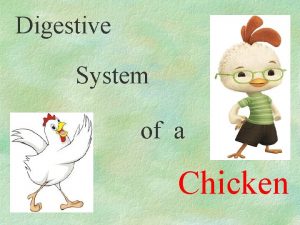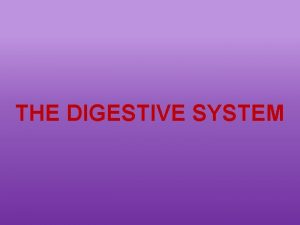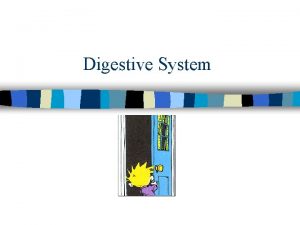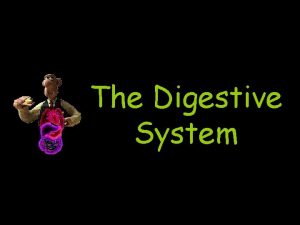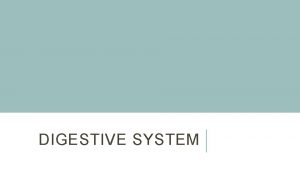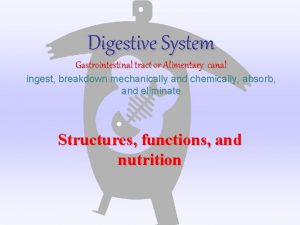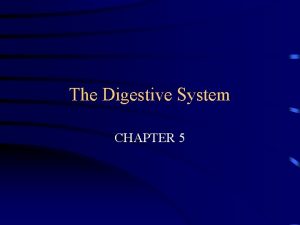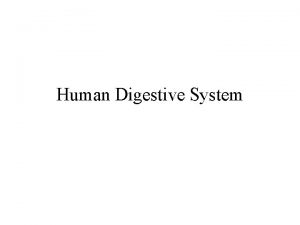Digestive System Role of the digestive system ingest





















- Slides: 21

Digestive System Role of the digestive system: • ingest food • break food down into small molecules that can cross plasma membranes • absorb nutrient molecules • eliminate nondigestible remains (egestion)

Incomplete vs. Complete digestive system • • incomplete digestive system has a single opening – mouth (ex. planaria) - food and waste enter and exit the mouth – nutrients are distributed by diffusion complete digestive system has a mouth and an anus (ex. earthworm) – mouth takes in food, digestive tract digests and absorbs nutrients, undigested remains leave the body through the anus

Human Digestive System – tube within a tube body plan

1. Mouth – mechanical and chemical digestion • food is chewed • food is mixed with saliva made by three major pairs of salivary glands – send saliva to mouth through ducts • saliva contains salivary amylase – enzyme that begins digestion of starch • food mixed with saliva forms a mass called the bolus

2. Pharynx – back of throat with openings to esophagus and trachea • epiglottis covers glottis to prevent food from entering trachea • food passes into esophagus • Esophagus – tube made of muscle through which food passes to stomach • peristalsis – contractions of muscles to move food down esophagus (as well as all muscular movement to move food through entire digestive system)


3. • • • Stomach – thick-walled, J-shaped organ that lies on the left side of body under diaphragm – storage, chemical and mechanical digestion of food epithelial lining of stomach contains millions of gastric pits which lead to gastric glands produce gastric juices containing: – HCl (p. H around 2) – kills bacteria and other microbes, promotes the activation of pepsinogen into pepsin – pepsinogen – inactive precursor to pepsin – enzyme that breaks down protein thick layer of mucus protects the stomach contents are called chyme stomach is closed off by sphincters at both ends: – cardiac sphincter prevents food from going back up the esophagus – pyloric sphincter controls passage of chyme to small intestine


4. • • Small Intestine – coiled tube about 3 meters long, does chemical digestion and absorption of nutrient molecules digestion in the small intestine is accomplished by digestive secretions from: a) the liver, b) the pancreas, and c) the cells of small intestine itself The Liver and Gallbladder – provide bile to break down fat liver has many functions – storage of fats and carbohydrates for energy, regulation of blood glucose levels, synthesis of blood proteins, storage of iron and certain vitamins, conversion of ammonia to urea, and detoxification of other harmful substances in digestion, the liver produces bile (mixture of bile salts, water, other salts, and cholesterol) – a liquid made by liver and stored in gallbladder has a duct leading to small intestine (bile duct) bile acts as an emulsifying agent, breaking large globs of fat into microscopic particles this increases the surface area available for lipases (enzymes) to act on fats


• Pancreas – lies in loop between the stomach and small intestine • made of two types of cells – one produces hormones to regulate blood sugar levels, the other produces pancreatic juice released into small intestine • pancreatic juice contains sodium bicarbonate (neutralize stomach acid), pancreatic amylase (digests carbohydrates), pancreatic lipase (digests lipids), and pancreatic proteases including trypsin, chymotrypsin, and carboxypeptidase (digest proteins)


• • • small intestine wall is studded with cells that are specialized to complete digestion and absorb nutrient molecules enzymes such as proteases, sucrase, lactase, maltase and lipase are embedded in the membranes of the cells final phase of digestion occurs as nutrients are being absorbed into the cell most absorption of nutrients into blood occurs in small intestine Fats are absorbed into the lymphatic system (lacteal)

• • small intestine wall is highly folded to increase surface area for absorption folded surface is covered by tiny fingerlike projections called villi (0. 5 to 1. 5 mm in length) each individual cell of the villi has further, microscopic extension called microvilli – further increases surface area for absorption villi are surrounded by capillaries to carry off the absorbed nutrients

• Products of digestion are absorbed when they make contact with epithelial cells of the villi – Absorbed by active transport – Products of digestion include: • • • Monosaccharide sugars Amino acids Fatty acids Glycerol Vitamins and minerals • Assimilation occurs if absorbed nutrients are used to build larger molecules in the cell (i. e. amino acids used to build a protein)


5. • • • Large Intestine – about 5 feet long, divided into the colon (most of its length) and the rectum (last 6 inches) leftovers of digestion flow into large intestine (mixture of water, undigested fats and proteins, indigestible fibers) contains large population of bacteria that live on unabsorbed nutrients synthesize vitamin B 12, thiamin, riboflavin, and vitamin K cells that line the large intestine absorb these vitamins, leftover water, and salts after absorption of water, waste becomes semisolid feces (consists of indigestible waste and bacteria) feces stored in rectum – expansion of rectum stimulates desire to defecate


Examples of Digestive Enzymes Salivary Amylase Pepsin (protease) Pancreatic Lipase Salivary glands Gastric glands (stomach) Pancreas Substrate Starch Proteins (polypeptides) Lipids (triglycerides) Products Maltose and glucose amino acids Glycerol and fatty acids Source Optimum Neutral (p. H 7) Acidic (p. H 3) p. H Neutral 7) (p. H

Nutrition animal nutrients fall into five categories: 1) lipids, 2) carbohydrates, 3) proteins, 4) minerals, and 5) vitamins 1. Vitamins – organic compounds that the body is unable to produce but uses for metabolic purposes • essential to cellular metabolism • Water-Soluble vitamins – cannot be stored, typically function as coenzymes in metabolic reactions (ex. vitamin C and vitamin B complex) • Fat-Soluble vitamins – can be stored • Vitamin A – used in production of pigments • necessary for proper functioning of eye (deficiency causes night blindness – found in green and yellow vegetables and milk products) • Vitamin D – used for Calcium absorption and metabolism (egg yolk, milk, fish oils) • Vitamin E – reacts with and detoxifies oxygen radicals in lipid metabolism • Vitamin K – essential for blood clotting

2. Minerals – required by body as constituents of cells and body fluids, and as structural components of tissue (Ca needed for bones and teeth as well as for nerve conduction and muscle contraction 3. Carbohydrates and Fats – primary source of energy 4. Proteins – serve as a source of amino acids to make new molecules § amino acids are used to make certain hormones, other amino acids, some neurotransmitters, and new proteins § liver can synthesize 9 of the 20 amino acids § essential amino acids – those that cannot be synthesized, must be supplied by the diet
 Site:slidetodoc.com
Site:slidetodoc.com Azure web role worker role example
Azure web role worker role example Symbolischer interaktionismus krappmann
Symbolischer interaktionismus krappmann Statuses and their related roles determine
Statuses and their related roles determine Hát kết hợp bộ gõ cơ thể
Hát kết hợp bộ gõ cơ thể Slidetodoc
Slidetodoc Bổ thể
Bổ thể Tỉ lệ cơ thể trẻ em
Tỉ lệ cơ thể trẻ em Gấu đi như thế nào
Gấu đi như thế nào Tư thế worm breton
Tư thế worm breton Bài hát chúa yêu trần thế alleluia
Bài hát chúa yêu trần thế alleluia Các môn thể thao bắt đầu bằng từ đua
Các môn thể thao bắt đầu bằng từ đua Thế nào là hệ số cao nhất
Thế nào là hệ số cao nhất Các châu lục và đại dương trên thế giới
Các châu lục và đại dương trên thế giới Công của trọng lực
Công của trọng lực Trời xanh đây là của chúng ta thể thơ
Trời xanh đây là của chúng ta thể thơ Cách giải mật thư tọa độ
Cách giải mật thư tọa độ 101012 bằng
101012 bằng độ dài liên kết
độ dài liên kết Các châu lục và đại dương trên thế giới
Các châu lục và đại dương trên thế giới Thể thơ truyền thống
Thể thơ truyền thống Quá trình desamine hóa có thể tạo ra
Quá trình desamine hóa có thể tạo ra
































